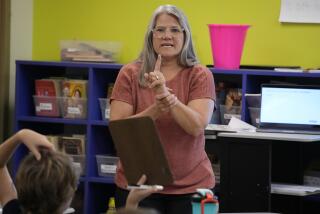The question for some of us is...
- Share via
The question for some of us is whether math can be made interesting. An affirmative answer becomes statistically more likely when it involves a stereotype-combating book like “Celebrating Women in Mathematics and Science.” Truly a rare find, this is a collection of gracefully told life stories of 22 women who made significant contributions to math and science throughout history. Some familiar names here--Marie Curie, Florence Nightingale, Elizabeth Blackwell, Dian Fossey, Jane Goodall--are balanced with many who deserve more fame, like Ada Byron Lovelace, the first computer programmer; Maria Mitchell, the American astronomer; Hypatia, a 4th century mathematician who became a martyr for her knowledge; and others. An inspirational resource for girls considering careers in these fields and amazingly interesting reading for the rest of us.
This and other new books about mathematics are making the whole topic less earnest, less lifeless, less of a drag than books we may remember from years back. One advantage of “How Math Works,” for example, is its jumpy magazine-style format--almost 200 pages of puzzles, tricks and hands-on experiments organized around the basic concepts of numbers, proportions, algebra, statistics, shapes, measurement and thinking skills. This eclectic approach, generously illustrated with colorful photographs and diagrams, not only demystifies math but nearly stands on its head to make the problem-solving process fun for the whole family to share.
“Calculator Mania!” is a simpler, sillier book, packaged with a bright orange calculator (battery included). Who could resist activities like “How to Get Really Rich With Really Busy Parents” or “The Top 10 Crawling Glop Situations” or “How to Psyche Out an Annoying Type of Person”? This assortment of zippy things to do with a calculator may not give you a mania for math, but it is certainly a painless way to spend hours absorbing how to think via numbers. What’s going on, as the publisher puts it, is “stealth learning.”
Clean, crisp graphics enhance “The Crayon Counting Book,” which is even simpler computational entertainment. Cheery verse and some very large crayons teach the youngest enumerators how to count by even and odd numbers. It is appropriately vibrant and animated.
After all this numerate exertion, some will want to take those crayons and reactivate that right side of the brain with “Loo-Loo, Boo, and Art You Can Do.” The title may be absurd, but not the contents, which are step-by-step instructions for 11 simple art projects for very young kids. The text is wittier than you could hope for in a math book and the activities are totally creative--old favorites like “Potato Prints” and “Face Masks” as well as “Stinky Clay” (made with pickle juice), “Bumpy Paint” (which you “smush” onto paper) and “Make Another You!” (and what to do if you get ticklish while making it).
****
CELEBRATING WOMEN IN MATHEMATICS AND SCIENCE. Edited by Miriam P. Cooney . Illustrated by Kevin C. Chadwick (National Council of Teachers of Mathematics: $22.50, 223 pp.)
HOW MATH WORKS: 100 Ways Parents and Kids Can Share the Wonders of Mathematics. By Carol Vonderman (Reader’s Digest: $24, 192 pp.)
CALCULATOR MANIA! By Jess Brallier Illustrated by Jack Keely (Planet Dexter: $12.99, 63 pp.)
THE CANYON COUNTING BOOK. By Pam Munoz Ryan and Jerry Pallotta . Illustrated by Frank Mazzola Jr. (Charlesbridge: $6.95, 32 pp.)
LOO-LOO, BOO, AND ART YOU CAN DO. By Denis Roche (Houghton Mifflin: $14.95, 32 pp.)
More to Read
Sign up for our Book Club newsletter
Get the latest news, events and more from the Los Angeles Times Book Club, and help us get L.A. reading and talking.
You may occasionally receive promotional content from the Los Angeles Times.








